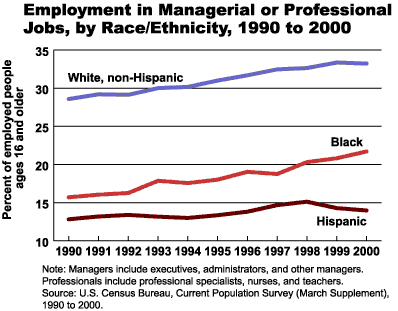
Racial Inequalities in Managerial and Professional Jobs
(February 2001) Title VII of the Civil Rights Act of 1964 sought to reduce racial inequality by eliminating discrimination in the labor market. Although few would disagree that discrimination is less of a problem today than it was in the 1960s, racial inequalities persist. Whites are more likely to be employed than blacks or Hispanics, and whites are more likely to hold managerial or professional jobs. In the past decade, the percentage of workers who are managers or professionals increased from 29 percent to 33 percent for whites, from 16 percent to 22 percent for blacks, and from 13 percent to 14 percent for Hispanics.1 This represents a decline in the white-collar employment gap between whites and blacks, a trend that may be linked to increasing college graduation rates for young black workers, especially women. Since 1990, the white-collar employment gap between Hispanics and other groups has widened. A high proportion of Hispanic workers are recent immigrants, who tend to be less educated than the native-born population.
Occupational differences are important because they affect potential earnings. In 2000, managers were compensated at the highest level of any major occupational group, at $37 per hour, including $27 for wages and $10 for benefits. Professional occupations had the second-highest compensation at $34 per hour, $26 of which was for wages. In 2000, blacks and Hispanics were almost twice as likely as whites to work in the service sector,2 with compensation at $12 per hour, $9 of which was for wages.
1 Professionals include professional specialists, nurses, and teachers.
2 Service workers include people in private household, protective service, food service, health service, cleaning service, and personal service occupations.

Source: Bureau of Labor Statistics: www.bls.gov/.
Citations
PRB analysis of data from the U.S. Census Bureau, Current Population Survey (March Supplement), 1970 to 2000; James Eaton and Manown Kisor, Jr., “Secular and Cyclical Patterns in White and Nonwhite Employment,” Monthly Labor Review (May 1996): 30–36; and Department of Labor, Bureau of Labor Statistics, “Employer Costs Per Hour Worked for Employee Compensation and Costs as a Percent of Total Compensation: Civilian Workers, by Occupational and Industry Group, March 2000,” accessed online at www.bls.gov/news.release/ecec.t02.htm on December 20, 2000.






